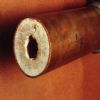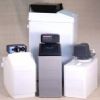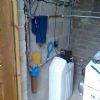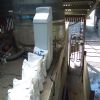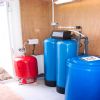Reduce scaling
Greater life expectancy and efficiency of heater elements
Supply and installation
Water softeners
Hard water is caused by rain and surface water dissolving mineral salts such as calcium and magnesium from local rock as it passes through. This solution of water and salts forms hard deposits of ‘scale’ within water systems particularly when heated, typically affecting kettles, showerheads, hot water tanks and central heating systems. This scale reduces the efficiency and life expectancy of the units whilst also requiring more energy to heat the water. Soaps and detergents do not work as well with hard water, so larger quantities are needed. Deposits are formed in baths, showers, toilets and basins, which are difficult to remove. Dishwashers and washing machines fed with hard water need significantly more maintenance and cleaning to work efficiently. There are no limits for hardness in the drinking water standard, however anything over 120mg/l (ppm) is considered to be hard.
Water softeners work using ion exchange resins; the resin beads have sodium ions attached to them. As the hard water passes through the softener, the calcium and magnesium ions swap places with the sodium ions. The treated water therefore contains an increased level of sodium (sodium limit is 200mg) and it is usually important to know the sodium, calcium and magnesium level within the water before specifying a softener. If necessary a blend valve can be used to blend raw water with treated water.
Once the resin beads become saturated with calcium and magnesium ions, they must be regenerated using salt. The sodium ions replace the calcium and magnesium ions on the beads and the process can start over again.
Softener media can be blinded by chlorine and iron and these should be avoided.
FWT supply water-softening salt in 25kg small tablet form.
The benefits of installing a water softener include:
- Saving up to 40% of the energy required to heat your water
- Significantly reducing your detergent consumption
- Prolonging the life of household appliances and pipework
- It can be better for sensitive skin as the reduced amount of soap required for washing means less drying of the skin caused by the removal of natural oils
Water conditioning -TAC
These units do not remove calcium and magnesium ions from water (as softeners do) but, rather, they change the hardness minerals from their ionic form to a crystalline form. In this form, calcium and magnesium do not attach to pipes, appliances, and fixture surfaces but they stick together. The crystals are so small, that they are readily rinsed away by the normal flow of water. This is called “template assisted crystallization,” or TAC. These units do not regenerate and therefore do not use salt.
TAC units are relatively new to our product range and although they are sensitive to the chemistry of the water in some circumstances they are a more suitable option than a traditional water softener.
The benefits of installing a TAC unit include:
- No salt or chemical usage
- No waste water
- Environmentally friendly with no electrical requirement
- Retains minerals such as calcium and magnesium
Whether specifying a softener or a TAC unit the first step is to have the water tested and for us to understand your requirements from the results and this information we will be able to advise and specify a suitable treatment system. The final specification will need to take into consideration the size of the property, peak flow rate and the hardness of the water.
| Further information is available | |||
|
|
||
| Related images in this section Click for a larger image and description |
|
|


